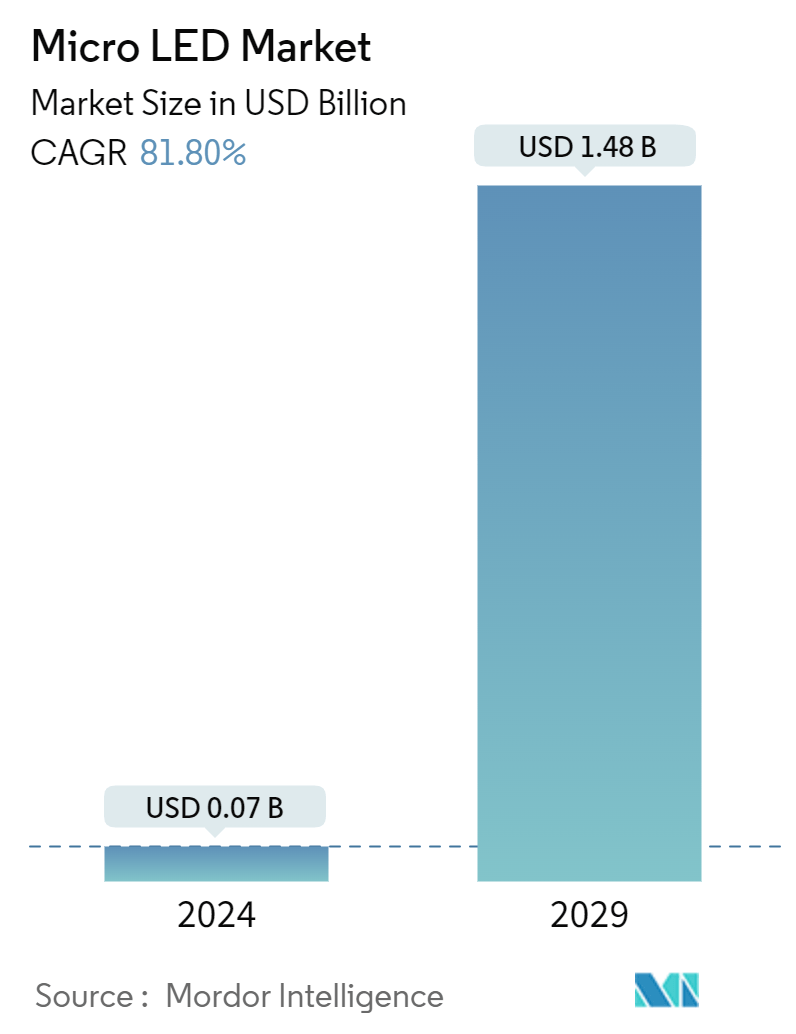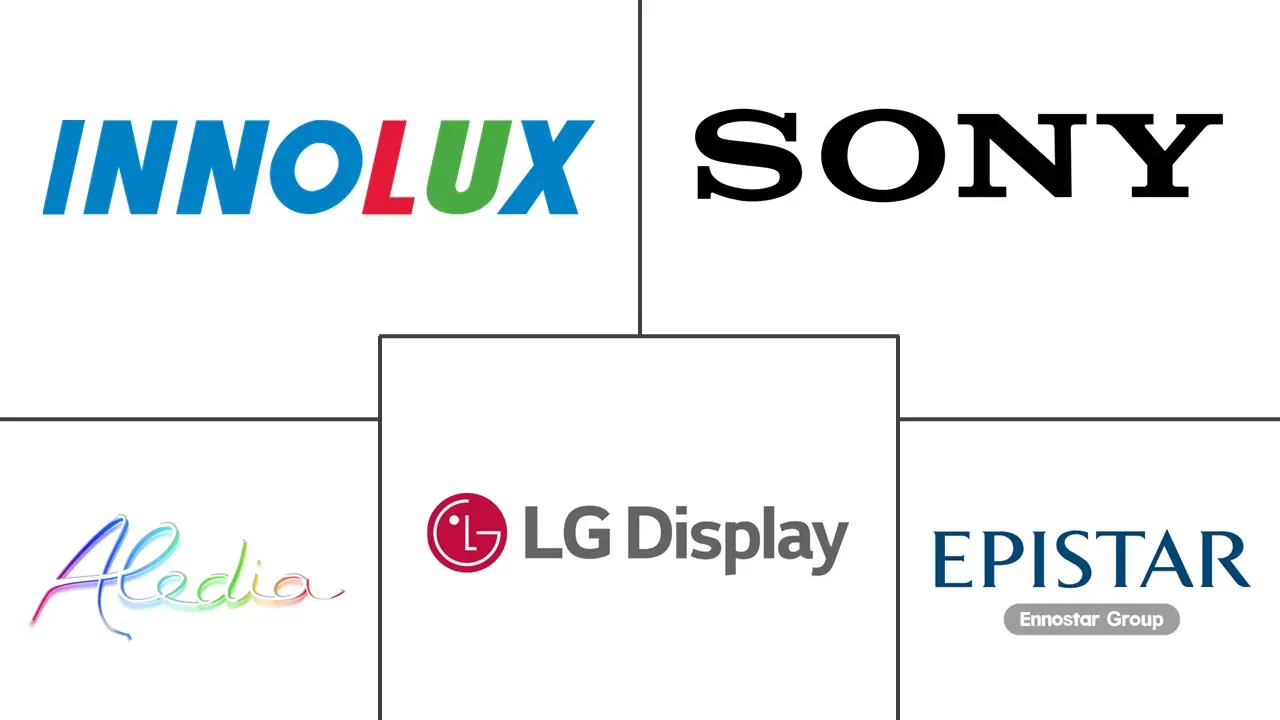Market Size of Micro LED Industry

| Study Period | 2019 - 2029 |
| Market Size (2024) | USD 0.07 Billion |
| Market Size (2029) | USD 1.48 Billion |
| CAGR (2024 - 2029) | 81.80 % |
| Fastest Growing Market | Asia Pacific |
| Largest Market | North America |
| Market Concentration | Low |
Major Players
*Disclaimer: Major Players sorted in no particular order |
Micro LED Market Analysis
The Micro LED Market size is estimated at USD 0.07 billion in 2024, and is expected to reach USD 1.48 billion by 2029, growing at a CAGR of 81.80% during the forecast period (2024-2029). In terms of shipment volume, the market is expected to grow from 13.30 thousand units in 2024 to 902 thousand units by 2029, at a CAGR of 132.5% during the forecast period (2024-2029).
Micro LED is a display technology that uses microscopic LEDs (light-emitting diodes) to create individual pixels. It offers high brightness, contrast, and energy efficiency. Micro LED displays are known for their potential to deliver superior picture quality and can be used in various applications, including TVs, monitors, and wearable devices.
- The micro LED market has grown significantly over the years. This is primarily due to the advancement of technologies such as AR/VR and the expansion of end-user industries across various regions. For instance, the transition toward 5G accelerates the demand for advanced mobile devices.
- Micro LED technology provides advantages over LCDs and OLEDs in brightness, resolution, contrast ratio, energy consumption, lifetime, and thermal stability, opening new possibilities in the display industry.
- In May of 2023, the world’s leading provider of long-distance wireless power solutions, Wi-Charge, introduced the industry’s most energy-efficient and high-performance wirelessly charged video display solutions for retailers, brands, and marketers to deliver directly to consumers at the point-of-sale (POS) on store shelves, in queue lines, and at restaurant tables. Wi-Charge developed the larger Wi-Spot 7", its new generation of video displays, which is available immediately in response to growing worldwide customer demand.
- Micro LED technology has been making waves in the consumer electronics industry, promising significant advancements in display technology. With its unique features and advantages, micro LED can potentially disrupt how users experience visual content on various devices.
- Micro LED technology has gained significant attention in recent years due to its potential for superior performance compared to other display technologies. Micro LEDs offer higher pixel density, lower power consumption, faster response time, higher luminance in direct sunlight, and wider viewing angles. These attributes make them suitable for various applications, including handheld devices and near-eye displays.
- The COVID-19 pandemic delayed production, and some new projects in the industry were delayed as many companies temporarily closed their facilities and the supply chain was interrupted. New technological developments might be affected during the challenging time as well. LEDinside shares its insights toward Micro LED technology development in such global uncertainty. It points out that next-generation display technology might be a chance to move a step forward.
Micro LED Industry Segmentation
The micro LED market is defined by the revenue generated from selling Micro Light Emitting Diode (LED) offered by different market players for a diverse range of end-user industries. The market trends are evaluated by analyzing the investments made in product innovation, diversification, and expansion. Further, advancements in the automotive and consumer electronics sectors are crucial in determining the growth of the studied market.
The micro LED market is segmented by application (smartwatch, near-to-eye devices (AR and VR), television, smartphone and tablet, monitor and laptop, head-up display, and digital signage), end user (consumer electronics, automotive, aerospace and defense, and other end users), geography (North America, Europe, Asia-Pacific, Rest of the World). The report offers market forecasts and size in value (USD) for all the above segments.
| By Application | |
| Smartwatch | |
| Near-to-eye Devices (AR and VR) | |
| Television | |
| Smartphone and Tablet | |
| Monitor and Laptop | |
| Head-up Display | |
| Digital Signage |
| By End User | |
| Consumer Electronics | |
| Automotive | |
| Aerospace and Defense | |
| Other End Users |
| By Geography | |
| North America | |
| Europe | |
| Asia-Pacific | |
| Rest of the World |
Micro LED Market Size Summary
The micro LED market is poised for substantial growth, driven by its advanced display technology that utilizes microscopic LEDs to create individual pixels, offering high brightness, contrast, and energy efficiency. This technology is gaining traction across various applications, including TVs, monitors, and wearable devices, due to its superior picture quality and advantages over traditional LCDs and OLEDs. The market's expansion is further fueled by the increasing demand for advanced mobile devices, spurred by the transition to 5G and the rise of AR/VR technologies. Companies like Wi-Charge are innovating with energy-efficient, wirelessly charged video display solutions, highlighting the technology's potential to disrupt consumer electronics. Despite challenges such as production delays during the COVID-19 pandemic, the micro LED market continues to attract attention for its promising performance attributes, including higher pixel density, lower power consumption, and wider viewing angles, making it suitable for handheld and near-eye displays.
The micro LED market landscape is highly competitive, with major players like Innolux Corporation, Sony Corporation, and LG Display Co. Ltd. actively engaging in partnerships and acquisitions to enhance their product offerings. Recent innovations include Innolux's seamless tiling displays and Sony's VERONA Crystal LED display for virtual production applications, showcasing the technology's versatility and high-quality output. The market's growth is also supported by the increasing adoption of digital signage, particularly in the United States, where technological advancements have led to reduced display panel prices and enhanced audience engagement. As digital signage becomes more prevalent in educational institutions and marketing strategies, the demand for high-quality displays continues to rise. The micro LED market's trajectory is further bolstered by ongoing developments and strategic initiatives by key industry players, positioning it for significant expansion in the coming years.
Micro LED Market Size - Table of Contents
-
1. MARKET INSIGHTS
-
1.1 Market Overview
-
1.2 Industry Value Chain Analysis
-
1.3 Industry Attractiveness - Porter's Five Forces Analysis
-
1.3.1 Bargaining Power of Suppliers
-
1.3.2 Bargaining Power of Buyers/Consumers
-
1.3.3 Threat of New Entrants
-
1.3.4 Threat of Substitutes
-
1.3.5 Intensity of Competitive Rivalry
-
-
1.4 Impact of COVID-19 Aftereffects and Other Macroeconomic Factors on the Market
-
-
2. MARKET SEGMENTATION
-
2.1 By Application
-
2.1.1 Smartwatch
-
2.1.2 Near-to-eye Devices (AR and VR)
-
2.1.3 Television
-
2.1.4 Smartphone and Tablet
-
2.1.5 Monitor and Laptop
-
2.1.6 Head-up Display
-
2.1.7 Digital Signage
-
-
2.2 By End User
-
2.2.1 Consumer Electronics
-
2.2.2 Automotive
-
2.2.3 Aerospace and Defense
-
2.2.4 Other End Users
-
-
2.3 By Geography
-
2.3.1 North America
-
2.3.2 Europe
-
2.3.3 Asia-Pacific
-
2.3.4 Rest of the World
-
-
Micro LED Market Size FAQs
How big is the Micro LED Market?
The Micro LED Market size is expected to reach USD 0.07 billion in 2024 and grow at a CAGR of 81.80% to reach USD 1.48 billion by 2029.
What is the current Micro LED Market size?
In 2024, the Micro LED Market size is expected to reach USD 0.07 billion.

